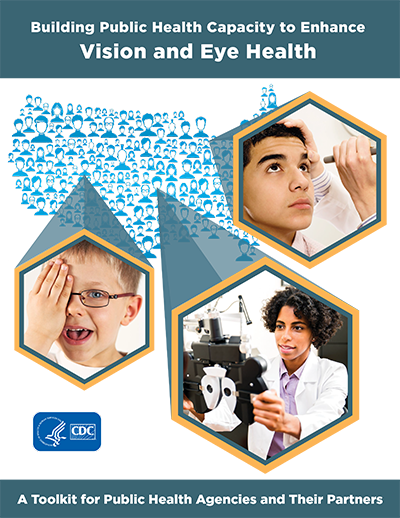Vision and Eye Health Toolkit
On This Page
Vision health is critically important for all aspects of a person’s life, including physical health, social engagement, education, employment, and socioeconomic position. Reduced vision affects a person’s ability to perform daily activities and increases a person’s risk of other health problems and premature death.1–5 It can also cause economic stress on individuals and society from direct medical expenses and indirect expenses related to loss of mobility and productivity. In the United States (US), direct and indirect expenses for eye disorders across all age groups were about $139 billion in 2013.6

Download the toolkit toolkit [PDF - 3 MB]
Unfortunately, vision health is rarely included in public health programs designed to prevent or manage chronic diseases because of limited resources and competing priorities. As a result, most public health agencies lack the framework or guidelines they need to appropriately address vision and eye health as a public health issue.
Building Public Health Capacity to Enhance Vision and Eye Health: A Toolkit for Public Health Agencies and Their Partners, developed by the Centers for Disease Control and Prevention (CDC), can help state, tribal, local, and territorial public health agencies and their partners assess the level of vision impairment in their communities, build effective partnerships, and implement effective and sustainable interventions to improve vision and eye health.
Vision Impairment in the United States
For information about common causes of vision impairment and eye disorders, visit the CDC’s Vision Health Initiative (VHI) Common Eye Disorders website
In 2015, about 3 million people aged 40 or older in the United States had vision impairment and 1 million were blind. More than 8 million people had vision impairment caused by an uncorrected refractive error, such as nearsightedness or astigmatism. These numbers are expected to double by 2050 because of the aging US population and the projected increase in chronic diseases, such as diabetes.7 An estimated 2.1 million children and adults younger than age 40 have an uncorrectable vision impairment or blindness.8
Studies have consistently shown that loss of vision is one of the greatest health fears that people have.9 The leading causes of blindness and vision impairment are primarily age-related eye diseases, such as diabetic retinopathy, age-related macular degeneration, cataract, and glaucoma. More than 30 million adults aged 40 or older are affected by age-related eye diseases. More than 7 million adults are affected by diabetic retinopathy, which is the leading cause of new cases of blindness in working age adults.10
Early diagnosis and timely treatment can often correct vision impairment and slow the progression of some conditions. Many interventions exist to help people with vision impairment, but information about and access to these services are often limited.11,12
Public Health Agencies Can Help
Vision impairment and blindness are a public health problem because they:
- Affect the lives of a large number of people.
- Cause a large amount of disease, disability, and economic burden and reduce quality of life.
- Are predicted to get worse in the next 30 years.
- Are perceived by the public to be a threat.
- Can be addressed through community or population-level interventions.13
Coordinated efforts by public health agencies and partners are needed to encourage policies and programs that:
- Emphasize the importance of preserving vision and eye health.
- Reduce modifiable risk factors.
- Improve timely detection, treatment, and management of vision impairment and eye disorders.
How to Use This Toolkit
Public health agencies and their partners can use the information in this toolkit to improve vision and eye health in their community. Four actions are recommended and described in the following sections.
Each section also contains a narrative, called “From the Field,” that describes how public health practitioners are working to promote vision and eye health at state or local levels. These practitioners offer practical suggestions based on their experiences.





















.png)












No hay comentarios:
Publicar un comentario